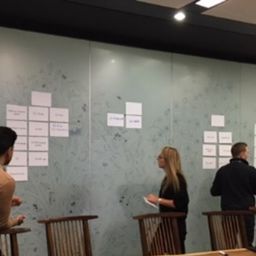
As discussed in a previous post card sorting is a method of getting users to group components in order to get an insight and understanding of how their thought processes move when navigating a website. There are three types of card sorting: open, closed and hybrid and a variety of methodologies that can be applied to each.
There is pretty general agreement that there is an upper limit on the number of cards to have in a sort but the general consensus seems to be 40-50 as the optimal number with not many more than this producing loss of focus and clarity of thinking.
Creating the Cards
The cards need to be created (and these might be physical or digital cards). This requires a good amount of preparation as if the items are not correct the sorting will be less than useful. A good way of doing this is brainstorming the areas to be tested with people in the organisation who are familiar with the subject and issues. This exercise can then be refined into a more definitive list and then the categories decided and appended to the exercise.
Open, Closed or Hybrid Card Sorting?
You then need to decide how much freedom or restriction you want to implement. If you are looking for very clear indicators on a closely defined and limited area you might wish to confine your participants to the subjects and categories you have predetermined. This way the results will be within a strictly defined framework so should be easier to collate and analyse. A closed test would therefore be the best solution in this situation.
If you are seeking more insight into the thought processes or users or looking for linkages and indicators that you might not previously have considered you are probably better using the open approach and letting the users create their own items and classifications if they feel the need. To get the best of both worlds you can take a hybrid approach with a rigidly controlled first pass followed by a less structured repetition.
Carrying out the Research
How you conduct the test can also vary. If you are seeking a really in-depth analysis of how the user is thinking you might conduct a one to one test with an individual moderator present all the time so the tester can articulate their thoughts and explain why they taking certain steps or where they are finding problems. This can become a dialogue and enhance the understanding or explore areas that might otherwise go unnoticed.
It is more common to conduct group sessions simply because you get a wider variety of experiences and answers and it is much quicker than a series of individual sessions. These can be conducted in one room with a briefing and materials provided and a moderator available to observe and answer queries. It can also be conducted remotely using computer linked over the internet. Whatever method is used participants should be encouraged to record their thoughts, ideas, problems etc so they can be assessed and analysed by the design/project team.
If you are interested in learning more about this technique, why not ring us on +44(0)800 0246247 or email us at hello@ux247.com

















